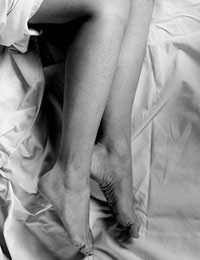Bill Brandt

Bill Brandt is generally considered one of the great pioneers of photography. He developed on the advances being made by some of his esteemed friends and colleagues ultimately ending up as one of the most innovative photographers of the 20th Century.
Early Career
Brandt was born in Hamburg in 1904. He was diagnosed with tuberculosis at a young age, and spent the first portion of his life in hospital in Switzerland. Around 1929, having been cured of his disease, Brandt was introduced to Ezra Pound by a mutual friend. Pound was the epicentre of the new modernist movement that was developing at the time, and went on to become the catalyst for the development of Vorticisim, generally thought to be the most important (and one of the shortest-lived) British art movements of the 20th Century. Brandt had, by the time he met Pound, decided that his goal was to become an independent photographer, and he took his portrait. Impressed, Pound introduced the young photographer to Man Ray. Brandt would later assist Ray in his Paris studio.Brandt worked with Ray from 1930 until, in 1933, he moved to London. Here, the photographer began working on documentary series which investigated the different layers of society in Britain. Brandt had been led to think of Britain as a paradise of freedom and wealth, but the reality that he found was very different: his first two books of London, ‘The English at Home’ and ‘A Night in London’, showed a stratified country in which the class system ruled, and one in which continuing economic crises had made life virtually impossible for a great number of people. Nowhere else is this epitomised more perfectly than in Brandt’s 1937 image ‘Coal Searcher Going Home to Jarrow’, a haunting, surreal medium-format image that presaged the photographer’s later transition to movie-like images.
Photoreportage
Brandt’s most famous work came during the Second World War, during which he was employed by the Home Office to create a photographic record of the public’s use of the tube as air raid shelters. The series was intended as a propaganda effort to demonstrate how well the population was coping, but in reality it produced a start portrait of a country in crisis. Brandt was also employed to document the famous architecture of London, with a view to preserving the memory of any important buildings that might be destroyed in air raids. This informed his later work, which concentrated on abstract representations of unpopulated landscapes.After the end of the War, Brandt began the transition to a totally new type of photography. He started to produce highly distorted images of nudes, initially using an incredibly basic, shutter-less camera which he acquired from the police. His nude series brings to mind the work of photographers such as Kertesz (who is covered in an article elsewhere in this section) and Atget, as well as the style of movie directors such as Hitchcock and Wells. These images have an intensely claustrophobic atmosphere, which is in part facilitated by the harsh lighting and unnatural environments in which the subjects are positioned.
Later, Brandt moved away from nudes and began making portraits of some of the leading lights of the contemporary art movements. This period in his work is, perhaps, best typified by his striking portrait of Francis Bacon. The extraordinary lighting in this image, apparently produced solely by a streetlight and the moon, again references films of the time. Similarly, the subject’s pose reminds the viewer of Brandt’s enthusiasm for encouraging his sitters to pose; he was not interested in naturalism or realism, but rather in unravelling something psychologically deeper.


Re: Photography Copyright Law
Hello, My name is Kimberly Wood and I run a business selling movie DVDs, and Blue-Rays. Both music and movies for me have always…
Re: Storing Your Photos Online
Flickr is fine just as a photo site, but plenty of people put pictures in albums on Facebook, for example, which is one way to store…
Re: Developing Your Own Film and Darkroom Basics
Hi, Please send me the details of new set up of digital color lab and having any expenses and cost of…
Re: What is the Copyright on Old Photographs to Use as Calendars?
Hi, I have an old photograph I got at a flea market, (a snapshot) that I want to use…